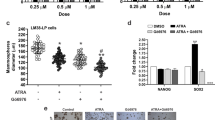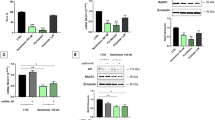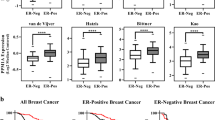Abstract
The anti-proliferative action of the seco-steroid hormone 1α,25-dihydroxyvitamin D3 [1α,25(OH)2D3] extends to some, but not all breast and prostate cancer cell lines. By elucidating the molecular mechanisms mediating the sensitivity of these cells, we can identify critical target genes regulated directly or indirectly by 1α,25(OH)2D3 and pathways potentially disrupted during transformation. In this study, we demonstrated the induction of expression of BRCA1 mRNA and protein as well as transcriptional activation from the BRCA1-promoter by 1α,25(OH)2D3 in the sensitive breast cancer cell line MCF-7. This was not observed in the 1α,25(OH)2D3-resistant breast cancer cell line MDA-MB-436. The induction of BRCA1 mRNA was blocked by cyclohexamide. This indicated that transcriptional activation was mediated indirectly by the vitamin D receptor (VDR). Inhibition of VDR protein levels by stable transformation of the anti-sense VDR in MCF-7 reduced the sensitivity of MCF-7 to 1α,25(OH)2D3 by 50-fold. In addition, the induction of BRCA1 protein and transcriptional activation of a BRCA1 promoter-luciferase reporter construct was abrogated in the stable transformant with the greatest reduction of VDR levels. Examination of other breast and prostate cancer cell lines revealed that sensitivity to the anti-proliferative effects of 1α,25(OH)2D3 was strongly associated with an ability to modulate BRCA1 protein. Furthermore, the expression of the estrogen receptor in these cell lines strongly correlated with their sensitivity to 1α,25(OH)2D3 and their ability to modulate BRCA1 expression. Taken together, our data support a model whereby the anti-proliferative effects of 1α,25(OH)2D3 are mediated, in part, by the induction of BRCA1 gene expression via transcriptional activation by factors induced by the VDR and that this pathway is disrupted during the development of prostate and breast cancers.
This is a preview of subscription content, access via your institution
Access options
Subscribe to this journal
Receive 50 print issues and online access
$259.00 per year
only $5.18 per issue
Buy this article
- Purchase on Springer Link
- Instant access to full article PDF
Prices may be subject to local taxes which are calculated during checkout





Similar content being viewed by others
Abbreviations
- VDR:
-
vitamin D3 receptor
- ER:
-
estrogen receptor
- VDRE:
-
vitamin D3 receptor enhancer
- RARE:
-
retinoic acid receptor enhancer
- 1α,25(OH)2D3:
-
1α,25-dihydroxyvitamin D3
- IE:
-
1α,25-(OH)2-20-epi-D3
- CDKI:
-
cyclin-dependent kinase inhibitor
- CHX:
-
cyclohexamide
References
Arason A, Barkardottir RB and Egilsson V. . 1993 Am. J. Human Genet. 52: 711–717.
Asou H, Koike M, Elstner E, Campbell MJ, Le J, Uskokovic MR, Kamada N and Koeffler HP. . 1998 Blood 92: 2441–2449.
Baker AR, McDonnell DP, Hughes M, Crisp TM, Mangelsdorf DJ, Haussler MR, Pike JW, Shine J and O'Malley BW. . 1988 Proc. Natl. Acad. Sci. USA 85: 3294–3298.
Campbell MJ, Elstner E, Holden S, Uskokovic M and Koeffler HP. . 1997a J. Mol. Endocrin. 19: 15–27.
Campbell MJ, Reddy SG and Koeffler HP. . 1997b J. Cell. Biochem. 66: 413–425.
Carrol AG, Voeller HJ, Sugars L and Gelmann EP. . 1993 Prostate 23: 123–134.
Carruba G, Pfeffer U, Fecarotta E, Coviella DA, D'Amato E, Lo Casto M, Vidali G and Castagnetta L. . 1994 Cancer Res. 54: 1190–1193.
Colston K, Colston MJ and Feldman D. . 1981 Endocrinol. 108: 1083–1086.
Deng HW, Li J, Li JL, Johnson M, Gong G, Davis KM and Recker RR. . 1998 Hum. Genetics 103: 576–585.
Elstner E, Linker-Israeli M, Said J, Umiel T, de Vos S, Shintaku IP, Heber D, Binderup L, Uskokovic M and Koeffler HP. . 1995 Cancer Res. 55: 2822–2830.
Fan S, Wang S-J, Yuan R, Na Y Meng Q, Erdos MR, Pestell RG, Yuan F, Auborn KJ, Goldberg ID and Rosen EM. . 1999 Science 284: 1354–1356.
Fasco MJ. . 1998 Mol. Cell. Endocrinol. 138: 51–59.
Futreal PA, Liu Q, Shattuck-Eidens D, Cochran C, Harshman K, Tavtigian S, Bennett LM, Haugen-Strano A, Swensen J, Miki Y, Eddington K, McClure M, Fyre C, Weaver-Feldaus J, Ding W, Gholami Z, Soderkvist P, Terry L, Jhaner S, Berchuck A, Iglehart JD, Marks J, Ballinger DG, Barrett JC, Skolnick MH, Kamb A and Wiseman R. . 1994 Science 266: 120–122.
Gaddipati JP, Mcleod DG, Heidenberg HB, Sesterhenn IA, Finger MJ, Moul JW and Srivastva S. . 1994 Cancer Res. 54: 2861–2864.
Gao X, Zacharek A, Salkowski A, Grignon DJ, Sakr W, Porter AT and Kenneth VI. . 1995 Cancer Res. 55: 1002–1005.
Gennari L, Becherini L, Masi L, Mansani R, Gonnelli S, Cepollaro C, Martini S, Montagnani A, Lentini G, Becorpi AM and Brandi ML. . 1998 J. Clin. Endocrin. Metab. 83: 939–944.
Gombart AF, Yang R, Campbell MJ, Berman JD and Koeffler HP. . 1997 Leukemia 11: 1673–1680.
Gudas JM, Nguyen H, Li T and Cowan KH. . 1995 Cancer Res. 55: 4561–4565.
Hengst L and Reed S. . 1996 Science, 271: 1861–1863.
Holt JT, Thompson ME, Szabo C, Robinson-Benion C, Arteaga CL, King M-C and Jensen RA. . 1996 Nature Genet. 12: 298–302.
Issacs WB, Bova GS, Morton RA, Bussemakers MJ, Brooks JD and Ewing CM. . 1994 Cold Spring Harbor Symp. Quant. Bio. 59: 653–659.
Ingles SA, Ross RK, Yu MC, Irvine RA, La Pera G, Haile RW and Coetzee GA. . 1997 J. Natl. Cancer Inst. 89: 166–170.
Jurutka PW, Remus LS, Whitfield GK, Thompson PD, Hsieh JC, Zitzer H, Tavakkoli P, Galligan MA, Dang HT, Haussler CA and Haussler MR. . 2000 Mol. Endo. 14: 401–420.
Korach KS. . 1994 Science 266: 1524–1527.
Konety BR, Schwartz GG, Acierno JS, Becich MJ and Getzenberg RH. . 1996 Cell Growth Diff. 7: 1563–1570.
Langston AA, Stanford JL, Wicklund KG, Thompson JD, Blazej RG and Ostrander E. . 1996 Am. J. Hum. Genet. 58: 881–885.
Leygue E, Dotzlaw H, Watson PH and Murphy LC. . 1999 Cancer Res. 59: 1175–1179.
Liu M, Lee M, Cohen M, Bommakanti M and Freedman L. . 1996 Genes Dev. 10: 142–153.
Lundin AC, Soderkvist P, Eriksson B, Bergman-Jungestrom M and Wingren S. . 1999 Cancer Res. 59: 2332–2334.
Miki Y, Swensen J, Shattuck-Eidens D, Futreal PA, Harshamn K, Tavtigian S, Liu Q, Cochran C, Bennett LM, Ding W, Bell R, Rosenthal J, Husey C, Tran T, McClure M, Fyre C, Hattier T, Phelps R, Haugen-Strano A, Katcher H, Yakumo K, Gholami Z, Shaffer D, Stone S, Bayer S, Wray C, Bodgen R, Dayananth P, Wards J, Tonin P, Narod S, Bristow PK, Norris FH, Helvering L, Morrison P, Rosteck P, Lai M, Barrett JC, Lewis C, Neuhausen S, Cannon-Albright L, Goldgar D, Wiseman R, Kamb A and Skolnick MH. . 1994 Science 266,: 66–71.
Miller GJ, Stapleton GE, Ferrara JA, Lucia S, Pfister S, Hedlund TE and Upadhya P. . 1992 Cancer Res. 52: 515–520.
Miller GJ, Stapleton GE, Hedlund TE and Moffat KA. . 1995 Clin. Cancer Res. 1: 997–1003.
Monteiro ANA, August A and Hanafusa H. . 1996 Proc. Natl. Acad. Sci. USA 93: 13595–13599.
Mosselman S, Polman J and Dijkema . 1997 FEBS Letts. 392: 49–53.
Munker R, Norman A and Koeffler HP. . 1986 J. Clin. Invest. 78: 424–430.
Murakami YS, Brothman AR, Leach RJ and White RL. . 1995 Cancer Res. 55: 3389–3394.
Ruffner H and Verma IM. . 1997 Proc. Natl. Acad. Sci. USA 94: 7138–7143.
Schwaller J, Koeffler HP, Nicklaus G, Loetscher P, Nagel S, Fey MF and Tobler A. . 1993 J. Clin. Invest. 95: 973–979.
Scully R, Chen J, Ochs RI, Keegan K, Hoekstra M, Feunteun J and Livingston DM. . (1997). Cell 90: 425–435.
Suarez F, Rossignol C and Garabedian M. . 1998 J. Clin. Endo. Metab. 83: 3563–3568.
Tamimi Y, Bringuier PP, Smit F, van Bokhoven A, Debruyne FM and Schalken JA. . 1996 Br. J. Cancer 74: 120–122.
Thompson ME, Jensen RA, Obermiller PS, Page DL and Holt JT. . 1995 Nature Genetics 9: 444–450.
Viljoen TC, van Aswegen CH and du Plessis DJ. . 1995 Prostate 27: 160–165.
Vladusic EA, Hornby AE, Guerra-Vladusic FK and Lupu R. . 1998 Cancer Res. 58: 210–214.
Xu C-F, Chambers JA and Solomon E. . 1997 J. Biol. Chem. 272: 20994–20997.
Yoshizawa T, Handa Y, Uematsu Y, Takeda S, Sekine K, Yoshihara Y, Kawakami T, Arioka K, Sato H, Uchiyama Y, Masushige S, Fukamizu A, Matsumoto T and Kato S. . 1997 Nature Genetics 16: 391–396.
Zhang H, Somasundaram K, Peng Y, Tian H, Zhang H, Bi D, Weber BL and El-Deiry WS. . 1998 Oncogene 16: 1713–1721.
Zhang S-H, Schwartz GG, Cameron D and Burnstein KL. . 1997 Mol. Cell. Endo. 126: 83–90.
Acknowledgements
Dr C-F Xu is gratefully acknowledged for the pGl1 BRCA1-reporter construct. We thank Dr Wesly Pike for kindly providing the VDR cDNA and Dr Milan Uskokovic for generously providing compound IE. Dr H Phillip Koeffler is a member of the UCLA Jonsson Comprehensive Cancer Center and holds an endowed Mark Goodson Chair of Oncology Research at Cedars-Sinai Medical Center/UCLA School of Medicine. Supported by NIH and United States Army Grants, a California Grant for Breast Cancer Research and also in part by the Parker Hughes Trust and the C and H Koeffler Fund.
Author information
Authors and Affiliations
Rights and permissions
About this article
Cite this article
Campbell, M., Gombart, A., Kwok, S. et al. The anti-proliferative effects of 1α,25(OH)2D3 on breast and prostate cancer cells are associated with induction of BRCA1 gene expression. Oncogene 19, 5091–5097 (2000). https://doi.org/10.1038/sj.onc.1203888
Received:
Revised:
Accepted:
Published:
Issue Date:
DOI: https://doi.org/10.1038/sj.onc.1203888
Keywords
This article is cited by
-
Reactive oxygen species in cancer: a paradox between pro- and anti-tumour activities
Cancer Chemotherapy and Pharmacology (2020)
-
Vitamin D3 from Ultraviolet-B Exposure or Oral Intake in Relation to Cancer Incidence and Mortality
Current Nutrition Reports (2019)
-
The role of vitamin D in ovarian cancer: epidemiology, molecular mechanism and prevention
Journal of Ovarian Research (2018)
-
Vitamin D/vitamin D receptor axis regulates DNA repair during oncogene-induced senescence
Oncogene (2016)
-
Vitamin D and the mammary gland: a review on its role in normal development and breast cancer
Breast Cancer Research (2012)



